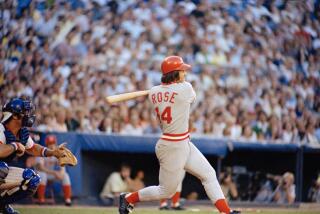‘Willie Mays: The Life, the Legend,’ by James S. Hirsch
The remarkable baseball life of Willie Mays can be measured in innumerable ways.
He started in the segregated Negro Leagues; when he retired in 1973 after 22 years in the major leagues, free agency was dawning. He was a bicoastal Giant who, in leading the team to San Francisco from New York in 1958, helped pioneer the westward expansion of professional sports.
Mays practically invented the term “five-tool player,” registering sublime stats: 660 homers, 3,283 hits, 338 stolen bases. His standout defensive gem during Game 1 of the 1954 World Series, known simply as “the Catch,” remains a magical diamond moment. His ebullient play -- underscored by that evocative nickname, “the Say Hey Kid” -- defined his legend.
As passionate as Mays was on the field, he was inscrutable away from the clubhouse. That’s not to say he was overlooked: He inspired “Willie’s Time,” a memoir by his friend Charles Einstein, as well as Arnold Hano’s “A Day in the Bleachers,” which details “the Catch.” He also participated in at least three ghostwritten autobiographies.
Now, with Mays’ cooperation, James S. Hirsch has written “Willie Mays: The Life, the Legend,” a book that seeks to clarify the man behind the mitt.
Born in 1931 in Alabama, Mays was raised by his often-absent father, nicknamed Cat, and his mother’s two younger sisters. Cat never revealed his family’s history to his son and, writes Hirsch, “Willie absorbed every side of his father’s personality. As an adult, he vigorously guarded his privacy, rarely talking to his friends, let alone the press, about his youth, his family, or his personal feelings.”
Cat, Hirsch notes, also passed along his can’t-we-all-get-along temperament. Mays claimed not to mind that African Americans were shunted to the balconies of movie theaters because, he maintained, “we got the better view.” All he ever said publicly about Bull Connor, the broadcaster-turned-police-commissioner in Birmingham, was that “he got overexcited announcing ball games.”
Thanks to his athletic ability, Mays escaped the insidious racism of the Deep South. He reached his teens just as Jackie Robinson was breaking major league baseball’s color barrier. He was equally fortunate to arrive in New York in 1951. With three contending teams and a surfeit of stars (the Yankees’ Mickey Mantle and the Dodgers’ Duke Snider were roaming the outfield), New York was the national pastime’s capital in the 1950s.
Giants Manager Leo Durocher coddled him, while fans and journalists embraced him. In the fall of his rookie season, Mays was kneeling in the on-deck circle when Bobby Thomson crushed every Dodgers fan’s heart with his legendary pennant-winning home run, “the shot heard ‘round the world.”
Mays spent most of the next two seasons in the Army (mostly playing ball), then returned to the Polo Grounds in 1954. It was in that ballpark that his dramatic World Series catch-and-throw robbed the Cleveland Indians’ Vic Wertz of a potential game-winning blow and helped the Giants to their first championship since 1933.
The triumph was Mays’ only title. That he never brought a World Series victory to San Francisco helps explain why, after the Giants moved there, the city never fully accepted him.
Of course, as Hirsch points out, on the West Coast Mays was no longer the effervescent man-child who had played stickball with kids in Harlem.
His limited education left him with little grasp of finances, and he accumulated heavy debt. His first marriage ended in a nasty divorce. His second wife, who is still alive, has Alzheimer’s.
Mays also found himself out of step with the changing times (and the emerging counterculture). In 1963, when a bomb killed four African American girls at a Birmingham church, he did not visit his hometown or make a statement.
Instead, he took up golf, convinced that joining previously white-only country clubs represented progress. When critics (including Jackie Robinson) called him an Uncle Tom, Mays retreated further.
“Willie Mays” is a thoroughly researched and sympathetic book that will probably stand as the definitive biography of baseball’s greatest performer. What’s disheartening is that, in peeling away the layers of Mays’ insularity, Hirsch has found a prickly personality and a naive apologist.
Perhaps that’s the price Mays paid in devoting his soul to baseball. But the book also raises several unanswered questions. The cause of Mays’ numerous collapses and hospitalizations remains murky. His non-denial of alleged amphetamine use reads like it came from Bill Clinton, a golfing buddy.
And, as Barry Bonds’ beloved godfather, shouldn’t Mays have something to say about his missteps?
Hirsch tends to excuse Mays for his transgressions, as will most of us. That speaks to his considerable legacy. Some 55 years after reaching over his shoulder to snare Wertz’s sure-fire triple, Mays still inspires a kind of awe.
Davis is writing a book about the 1908 Olympics.
More to Read
The biggest entertainment stories
Get our big stories about Hollywood, film, television, music, arts, culture and more right in your inbox as soon as they publish.
You may occasionally receive promotional content from the Los Angeles Times.










